Imagine a scenario where, instead of sending your child to their room in a fit of rage, confiscating their tablet for an extended period, or placing them in time-out, you invite them to take a moment alone to meditate and process their emotions. This innovative method of discipline is gaining traction in various schools, resulting in significant transformations in student behavior. Is it possible to adopt these insights into our parenting strategies?
Examining Mindfulness versus Traditional Discipline in Educational Settings
A recent article from Forbes highlights that conventional disciplinary measures in schools, such as detention and suspension, often fail to effectively address misbehavior. These methods can foster resentment and strain the relationship between students and teachers, leading to increased negativity when students miss out on enjoyable activities like recess.
Taking a pioneering stance, the Holistic Life Foundation (HLF), a Baltimore-based nonprofit, has implemented mindfulness programs in schools, replacing traditional punishment techniques. Their mission focuses on enhancing the wellness of children in underprivileged communities by promoting yoga, mindfulness, and self-care. HLF trains educators and assists schools in developing mindfulness initiatives, while also offering workshops across the country.
Successful Mindfulness Programs in Schools
Numerous schools nationwide are incorporating mindfulness into their curricula, but those collaborating with HLF stand out due to their unique approach to addressing negative classroom behavior. Two notable examples are Robert W. Coleman Elementary School and Patterson High School, both in Baltimore, which have experienced remarkable changes in student conduct through mindfulness practices.
At Robert W. Coleman Elementary School, the “Mindful Moment Room” serves as an alternative to detention. Disruptive students are invited to this cozy space, adorned with soothing lights and comfortable seating, where they can learn techniques to manage their stress and anger. Here, they engage in deep breathing exercises and meditation, guided by a trained staff member, allowing them to regain their composure before returning to class. Since the introduction of the Mindful Moment Room, the school has reported a drastic decrease in suspensions, going from four in the 2013-2014 school year to none in subsequent years.
Patterson High School offers a similar “Mindful Moment Room” available throughout the day for students experiencing emotional distress. Here, they are assigned a “Mindfulness Instructor” who helps them navigate their feelings through mindfulness practices like breathing exercises and yoga. The result has been a noticeable drop in suspensions and an overall calmer school environment.
The Benefits of Mindfulness
According to Jon Kabat-Zinn, a leading expert on mindfulness, it is the conscious act of paying attention to the present moment without judgment. Practicing mindfulness enables individuals to understand the connection between their thoughts, emotions, and physical sensations. This heightened awareness fosters a sense of peace, empathy, and emotional control, which can lead to improved academic performance and reduced anxiety in children.
Research underscores the transformative impact of mindfulness, with studies indicating that meditation can enhance focus, decrease stress levels, and even lead to structural changes in the brain associated with decision-making and emotional regulation.
Students from these Baltimore schools have shared their experiences, highlighting the positive influence of the Mindful Moment Room on their lives. Comments like, “I can breathe and relax when I’m having a tough day” and “Mindfulness helps me stay in control” illustrate how these practices are helping them navigate their emotions better.
Implementing Mindfulness at Home
Vance Benton, the principal of Patterson High School, has embraced mindfulness at home, practicing it with his son each morning. HLF encourages a reciprocal teaching model, allowing children to share mindfulness techniques with their parents.
Creating a “calm corner” in your home could be a valuable addition, providing your children a space to retreat when they feel overwhelmed. As they engage in mindfulness, consider joining them in this practice to foster a serene family environment.
For more insights on fertility and family planning, check out this article on at-home insemination kits. Additionally, if you’re looking for comprehensive guidance on fertility treatments, visit this excellent resource.
In conclusion, integrating mindfulness into parenting may not only enhance children’s emotional regulation but also strengthen family bonds. By adopting these practices, parents can create a nurturing environment that encourages self-awareness and emotional resilience.
